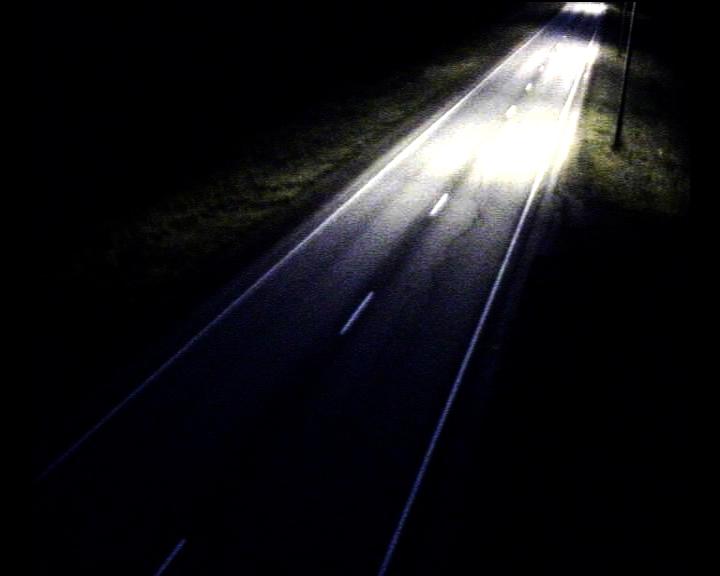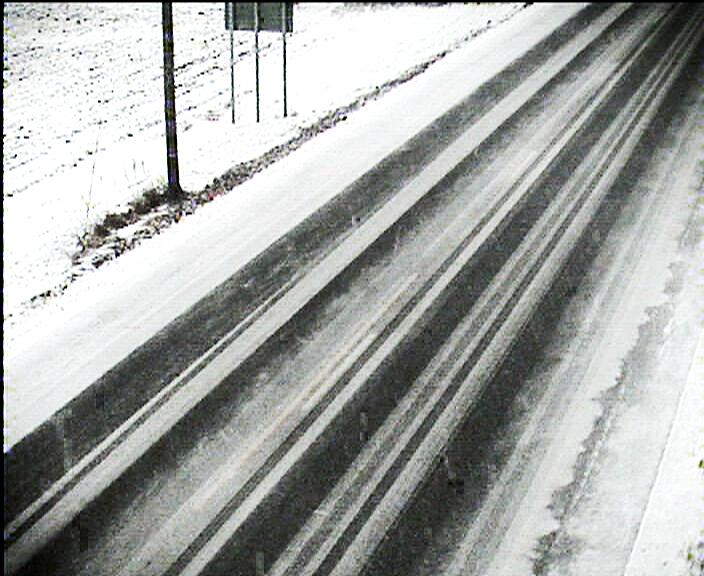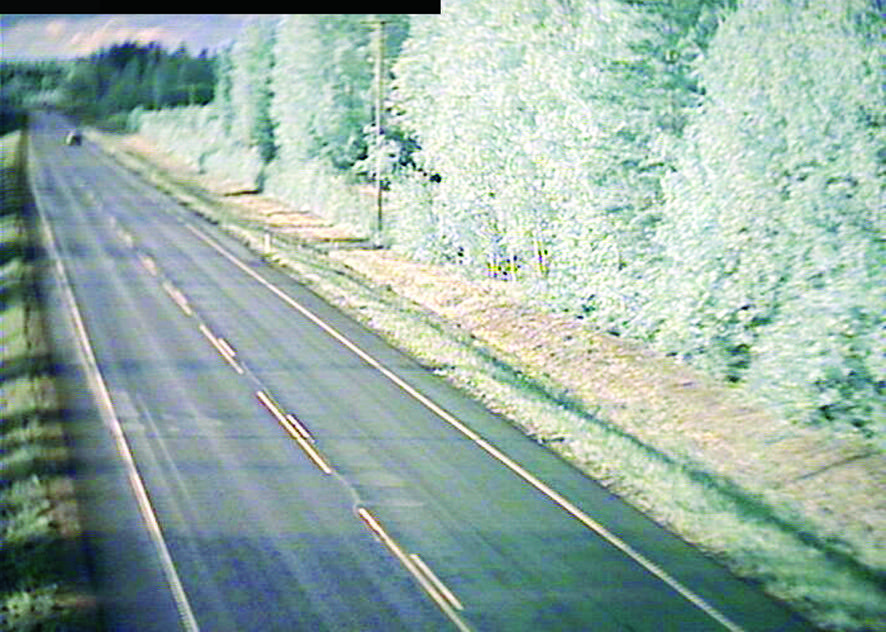Luukkaankangas – updated, revisited
In Finnland nehmen Webcams der Finnish Road Administration permanent Bilder aller wichtigen Straßen auf, die dann in einem Intervall von 15-30 Minuten ins Internet gestellt werden. Bevor sie also wegfahren, können die Finnen ihre Straßen zunächst als ein Bild einsehen, und entscheiden, ob sie sie benutzen wollen oder nicht. Entscheidend ist wohl, dass die Kameras die Bilder automatisch, ohne Kameramann, aufnehmen, es also bloße Funktionsbilder sind, ohne jegliche ästhetische Referenz. Der systematischen Leerstelle auf der Seite der Produktion steht eine hoch individualisierte Rezeption gegenüber.
Dariusz Krzeczek gestaltet - ebenfalls als User dieser Bilder - aus ihnen eine singuläre filmische Dramaturgie. Die serielle Montage der Einzelbilder, ihre Entfunktionalisierung und Raffung lässt diese nunmehr als gänzlich andere Bilder lesen. Die Straßen erleben eine eigentümliche Animierung, Beseelung. Sie werden als Organismen wahrgenommen, die sich mit den Licht und Schattenspielen, mit den Wetterverhältnissen und Jahreszeiten verändern. Die Straßen pulsieren, vibrieren, verwandeln sich nach scheinbar uneinsehbaren Gesetzen. Sie beeindrucken, da oft gar keine Autos zu sehen sind, als Gebilde mit selbstreferentiellem Charakter.
Von erhöhten Positionen aus konstruieren die Aufnahmen eine distanzierte, kontrollierende Visualisierung der Straßenzüge. Bei Foucault heisst es: "Je anonymer und funktioneller die Macht wird, umso mehr werden die dieser Macht unterworfenen individualisiert." Je intensiver die Macht der Road Administration mittels Webcams die Straßen kontrolliert, umso mehr erscheinen diese als Individuen, als einzigartige Organismen, die jeder für sich eine besondere ästhetische Existenzweise beanspruchen. Vielleicht bekommen demnächst auch die Landstraßen und Autobahnen Eigennamen, um ihrer Individualisierung gerecht zu werden.
(Marc Ries, © medienturm graz)
Das Video Luukkaankangas – updated, revisited behandelt die Verkehrslandschaft der Schnellstrassen und Autobahnen in Finnland. Sie stellen das Dispositiv der heutigen Mobilität dar, mit der eine spezfische Raumauffassung einhergeht. Sie bilden Transiträume ohne einen historischen oder geografischen Bezugspunkt zu definieren. Die Videoarbeit abstrahiert die verkehrstechnische Aufgabe der Strasse und fokusiert ihr formales Bild, als eine Linie, Band oder Hieroglyphe in der Landschaft.
In Finnland gibt es ein landesweit ausgebautes Strassenkontrollsystem (Finnish Road Administration), in dem Schnellstrassen und Landstrassen auf ihre Wetterlage hin mit Webkameras fotografiert, und in einem Interval von ca. 15-30 min ins Internet gestellt werden.
Zur Realisierung der Videoinstallation Luukkaankangas – updated, revisited wurden mehr als 20.000 Einzelfotos aus dem Internet heruntergeladen.
(Dariusz Kowalski)
Mit Luukkkaankangas, updated, revisited beginnt er eine Werkserie, in der er ausschliesslich aus dem Internet herunter geladene Einzelbilder von Webcams verwendet. Derartige Kameras werden in erster Linie zum Zweck der Überwachung installiert, ästhetische Überlegungen spielen dabei keine Rolle. Auch sind diese Aufnahmen nicht dazu gemacht, gespeichert zu werden, sie besitzen ausser dem Aktualitätswert keinerlei Relevanz. Üblicherweise werden die Einzelbilder automatisch überschrieben und verschwinden somit wieder für alle Zeiten. Kowalski eignet sich diese flüchtigen Bildfolgen aus dem World Wide Web an und aktualisiert somit ganz nebenbei das Genre des "Found-Footage-Films". Ein Großteil dieses Bildmaterials war ursprünglich nicht für die Veröffentlichung gedacht. Die Webcams, die teilweise illegal installiert waren, wurden „gehackt“ und auf einer Homepage öffentlich zugänglich gemacht. Über Jahre hinweg hat Kowalski aus diesem Fundus Einzelbild für Einzelbild herunter geladen. Überraschend ist, wie es dem Filmemacher in dieser Werkserie gelingt, den Webcam-Aufnahmen in geringer Auflösung einen ganz eigenen ästhetischen Reiz abzugewinnen.
In Luukkkaankangas, updated, revisited sind ausschliesslich einsame Landstrassen aus der titelgebenden Region Finnlands zu sehen. Diese Verkehrs-Webcams wurden auf erhöhten Standpunkten montiert, um die Autofahrer über den aktuellen Zustand des jeweiligen Streckenabschnitts zu unterrichten. In dem athmosphärisch dichten und etwas unheimlichen Video treten diese Strassen zu unterschiedlichen Tageszeiten und Witterungsbedingungen in Erscheinung.
(Norbert Pfaffenbichler, In: KOLIK FILM, Sonderheft 17 / 2012)
Claudia Slanar zu Luukkaankangas
(Claudia Slanar in Barbara Pichler, Andrea Pollach (ed): moving landscapes Landschaft und Film. Synema 2006)
Notions on “LUUKKAANKANGAS - updated, revisited” (EN)
Text: Marc Ries
1.
The image of the street in the work of Dariusz Kowalski exists already beforehand, in a manner of speaking as an a priori. One could perhaps formulate it this way: the condition of the possibility to have street as image, lies in the social-historical compulsion to double everything real-existing as imaginary, better: as medial one. To the twenty-first century applies, that all experience is preceded already by an image of the to-be-experienced. This has nothing to do with culture industry, but with an ontological regrouping. The image is, in accordance with today´s aesthetical theory, not any more last element of a being-hierarchy, but equal part to all other elements, foremost to thought. An iconic paradigm - in medicine, the natural sciences and humanities, but also in the military research - manifests itself against the logical-symbolic paradigm of the early twentieth century: an iconic turn is added to the linguistic turn .
“Visualization” has advanced to a cognition-theoretical leading figure of many fields of our culture, to which experience and knowledge have to submit. These are dependent on, first of all result, representatives of the results of the visualization. Also, it does not surprise that in Finnland on all important roads, webcams of the Finnish Road Administration record or photograph the street as such, in its being as it is, in its “condition”; these images are then placed in the internet in an interval of fifteen to thirty minutes. Before their departure, the Finns thus first can read back their streets as an image, to visualize an image of the streets and to decide whether they use them, pass over them or not. Crucial is perhaps that the cameras record the images automatically without cameraman, they thus are mere function-images without any aesthetical reference. The systematic blank on the part of the production faces a highly individualized reception. The iconic verifyability of the quality of the street is a pleasure-oriented procedure, everyone is enabled to motivate his agency qua image - not just by means of language or other sign systems. Presumably, the actual trip on the streets then becomes a real-road-movie.
2.
The manipulation of the individual images, produced by Dariusz Krzeczek in animated video sequences, is a plausible consequence of this logic of acting. The user Kowalski designs a singular cinematic dramaturgy of the images, which he appropriates himself . According to the author, the video, “abstract of the traffic-related task of the street images, focuses on the formal image of the street as line, lane or hieroglyph in the landscape”. The serial montage of the individual images, their disfunctionalizing and gathering, partly in diachronic, partly in synchronous combinations, lets these become readable as completely different images. Through the study the streets experience a peculiar animation, inspiration. They are perceived as organisms that are changing with the play of ligths and shades, with the weather conditions and seasons. The streets pulsate, vibrate, mutate according to seemingly mysterious laws. They impress, since often no cars are seen, as a formation with self-referential character. And when automobiles flare up as out of the nothingness, then they are rather citings of themselves, than independent referees. Dariusz Kowalski entitles his work “aesthetical analysis”; the images, they exist already as found-footage material of a street control- and multi media system - the point now is to superelevate them by means of specific procedures, to submit them to an interpretation which shows its motif, the street, in such a way as it hardly has been read and understood before. The industrial artefact street experiences in these animations a “resurrection” as aesthetical one, is recognized as image and comprehended as individuum. This observation is supported by the “frame work” (Polyani) of the webcam-images, meaning the always constant remaining long shot from the bird´s-eye view. Positioned in elevated locations, the recordings fabricate a distanced, controlled vizualization of the street blocks, trying to offer a nearly complete “supervision” of the area. All this in a peculiar manner meets Foucault´s comments on individualization as effect of discipline and control: “the more anonymous and functional the power becomes, the more individualized become those who are subjected to this power”. The more intense the Road Administration´s power controls the streets by means of webcams, the more these appear as individuals, as unique organisms, claiming each on its own a particular aesthetical way of existance. Perhaps, the country roads, motor highways and motorways are given proper names, in order to do justice to their individualization.
Notions on “LUUKKAANKANGAS - updated, revisited” (EN)
Text: Marc Ries
1.
The image of the street in the work of Dariusz Kowalski exists already beforehand, in a manner of speaking as an a priori. One could perhaps formulate it this way: the condition of the possibility to have street as image, lies in the social-historical compulsion to double everything real-existing as imaginary, better: as medial one. To the twenty-first century applies, that all experience is preceded already by an image of the to-be-experienced. This has nothing to do with culture industry, but with an ontological regrouping. The image is, in accordance with today´s aesthetical theory, not any more last element of a being-hierarchy, but equal part to all other elements, foremost to thought. An iconic paradigm - in medicine, the natural sciences and humanities, but also in the military research - manifests itself against the logical-symbolic paradigm of the early twentieth century: an iconic turn is added to the linguistic turn .
“Visualization” has advanced to a cognition-theoretical leading figure of many fields of our culture, to which experience and knowledge have to submit. These are dependent on, first of all result, representatives of the results of the visualization. Also, it does not surprise that in Finnland on all important roads, webcams of the Finnish Road Administration record or photograph the street as such, in its being as it is, in its “condition”; these images are then placed in the internet in an interval of fifteen to thirty minutes. Before their departure, the Finns thus first can read back their streets as an image, to visualize an image of the streets and to decide whether they use them, pass over them or not. Crucial is perhaps that the cameras record the images automatically without cameraman, they thus are mere function-images without any aesthetical reference. The systematic blank on the part of the production faces a highly individualized reception. The iconic verifyability of the quality of the street is a pleasure-oriented procedure, everyone is enabled to motivate his agency qua image - not just by means of language or other sign systems. Presumably, the actual trip on the streets then becomes a real-road-movie.
2.
The manipulation of the individual images, produced by Dariusz Krzeczek in animated video sequences, is a plausible consequence of this logic of acting. The user Kowalski designs a singular cinematic dramaturgy of the images, which he appropriates himself . According to the author, the video, “abstract of the traffic-related task of the street images, focuses on the formal image of the street as line, lane or hieroglyph in the landscape”. The serial montage of the individual images, their disfunctionalizing and gathering, partly in diachronic, partly in synchronous combinations, lets these become readable as completely different images. Through the study the streets experience a peculiar animation, inspiration. They are perceived as organisms that are changing with the play of ligths and shades, with the weather conditions and seasons. The streets pulsate, vibrate, mutate according to seemingly mysterious laws. They impress, since often no cars are seen, as a formation with self-referential character. And when automobiles flare up as out of the nothingness, then they are rather citings of themselves, than independent referees. Dariusz Kowalski entitles his work “aesthetical analysis”; the images, they exist already as found-footage material of a street control- and multi media system - the point now is to superelevate them by means of specific procedures, to submit them to an interpretation which shows its motif, the street, in such a way as it hardly has been read and understood before. The industrial artefact street experiences in these animations a “resurrection” as aesthetical one, is recognized as image and comprehended as individuum. This observation is supported by the “frame work” (Polyani) of the webcam-images, meaning the always constant remaining long shot from the bird´s-eye view. Positioned in elevated locations, the recordings fabricate a distanced, controlled vizualization of the street blocks, trying to offer a nearly complete “supervision” of the area. All this in a peculiar manner meets Foucault´s comments on individualization as effect of discipline and control: “the more anonymous and functional the power becomes, the more individualized become those who are subjected to this power”. The more intense the Road Administration´s power controls the streets by means of webcams, the more these appear as individuals, as unique organisms, claiming each on its own a particular aesthetical way of existance. Perhaps, the country roads, motor highways and motorways are given proper names, in order to do justice to their individualization.



